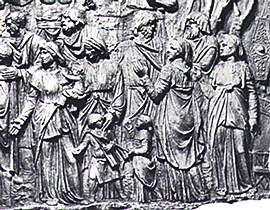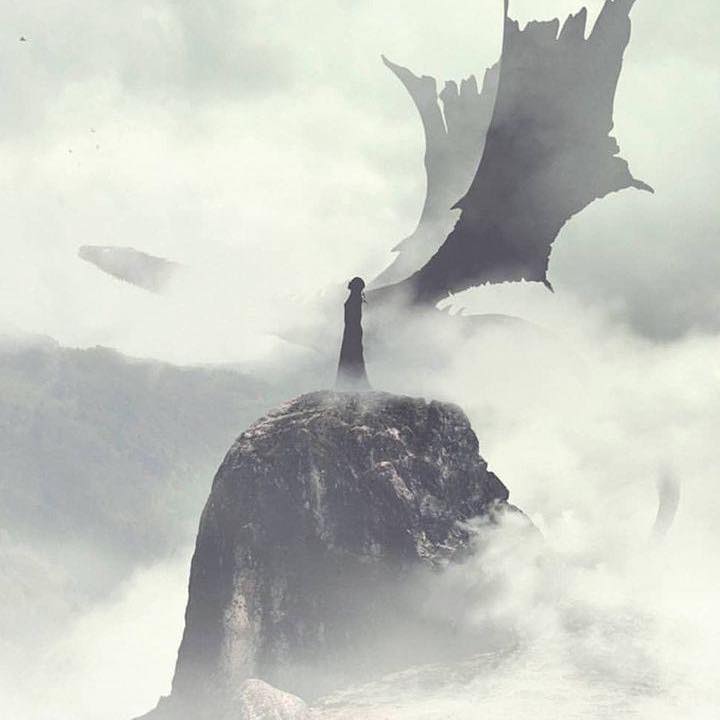The Dacians

Wolf, wolves... This is a notion that it is to be found in the Thracian dictionary. The name of the wolf it is not documented in Dacian or Thracian language, but it could be concluded. In the history of the Thracians from the north of the Danube, meaning Dacians and Gethians, the wolf took an important role. Any history of the romanian people describes the Dacians`s flag, which had a wolf`s head and a dragon`s tail, and when the wind blown, it produced a sound that scared the enemy`s armies.
The Dacian flag remains extremly important by the semnifications implied. Nicolae Iorga, one of romanian`s greatest historians, told that "the snake, the dragon from the Dacian flag, it is not only an animalic symbol, but the very essence of the ancestors`s religion!". In other words, the Dacian flag had a spiritual semnification and, as is understood for the dragon, it is also understood for the wolf. In his essay "From Zalmoxis to Gengis-Han", Mircea Eliade proposes an interpretation of this symbol under the title "The Dacians and The Wolves".
The Dacian Flag

His interpretation originates from the name "daoi" given to the Dacians by Strabon, and from the noun "daos", which in frigian means "wolf", the result - "Daoi" means "wolves". The stem of the word would be "dhau" - meaning to push, to grip, to strangle, from which derives the ilirican word "dhaunos" - meaning "wolf", the god Daunus or another god, Thracian, the god of war Kandaon or the lydian Kamdaules. Mircea Eliade chooses his examples from the only linguistic area related with the Thracians and the Dacians, the city Daousdava, from Moesia Inferior, between the Danube and the Balcans, meaning "The City of Wolves". A scytic kindred which haunted on the eastern side of the Caspic Sea was called "daoi" - the latins called it "Dahae" and the greeks "Daai", very probably from the iranian stem "dahae" - meaning "wolf". Southern of the Caspic Sea it was Hyrcania, in Eastern iranian "Vehrkana", western iranian "Varkana", from the stem "Vehrka" - meaning "wolf". All this names ment "The Wolves Country".
The same population was called in Arcadia "lycaons", as the state was "Lycaonia" or "Lucaonia" in Asia Minor. The spartan description of "Laconia" derives from the same stem. In Arcadia there was a God Lycaion, as there was an "Apollon The Lycagenet"; "lyca" corresponds to "wolf", and Apollo is the one born by the wolf. The examples given by Mircea Eliade are numerous and they can be multiplied. The demonstration is made by the anthropologic view of the races that beare the name of an animal, in our case, the wolf. The explanation of the presence of a wolf`s head on the Dacian flag must be found here. More complex is the ritual of initiation of the "young wolves", meaning the youngsters organised in manly closed organisations, which purpose is to make them pass those exams which made them looked like the breed they took as a symbol. Usually, the one who wants to borrows until identification the qualities of the beast, is the hunter. Killing the beast and wearing its skin, he becomes the god-animal; the breeder is the prototype of the warrior.
An iteresting fact is that "dances of the wolves" were played by certain tribes before the battles; in the view of Mircea Eliade, the Dacians are a warrior brotherhood, who had the wolf as a symbol. The difficulty would be that of difference in names: the Dacians (or "the wolves") are the Thracians situated in the northern part of the Danube, while the Thracians from the east are the Gaetes; are those Thracians wolves also? The examples given by the Orient, especially Hercynia, could give an affirmative answer. But there are other examples; for instance, the Persians had a flag with a wolf on it; in Turkestan it is still kept the image of a flag composed by a wolf`s head and a dragon; in the north-west of Iran and Armenia, the elite troops wore symbols of dragons. The same flags appeared in the roman army also; given the fact that the army was constituted fom easthern ethnic elements, this fact is not so surprising. What it is to remember is the high frequency of the symbol of the wolf at Thracians, Iranians, Germans. The german folklore also describes the custop of wearing the animal`s skin (the wolf or the bear), as the high frequency of the name "Wolf-Wulf" (the christian apostle of the goths was Wulfila).
The Lycan

|














